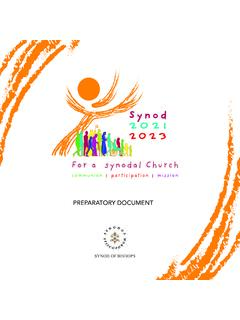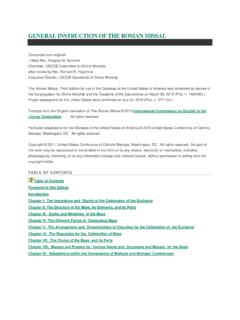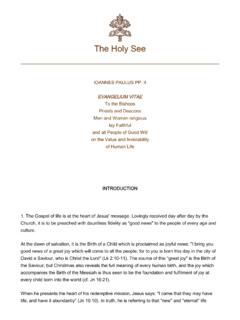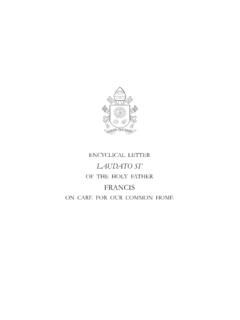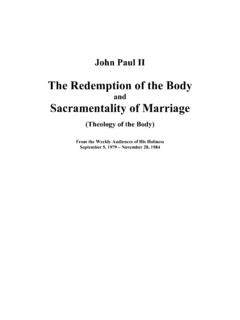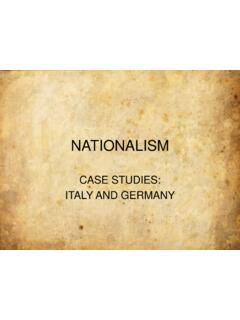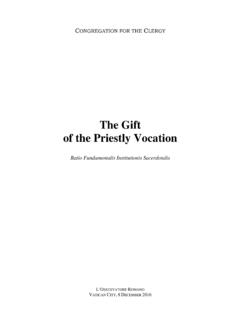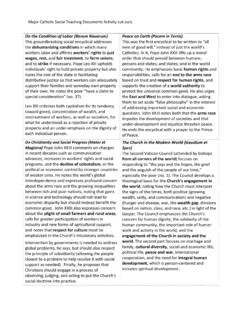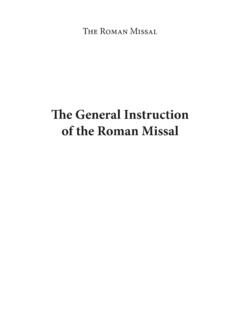Transcription of The Second Vatican Council Documents
1 The Second Vatican Council Documents Parish Study Package for Year of Faith INTRODUCTION. Vatican II and the Year of Faith Upon declaring the Year of Faith, Pope Benedict XVI reiterated the importance of the Vatican II Documents for the faithful of the Church. Many faithful are not familiar with the details about the Council , and particularly not with the specific content and importance of the Documents issued by the Council Fathers. This study guide addresses the key points of each of the Council Documents , and is meant as an introductory overview. Further study by the faithful is required for a proper understanding but this is the starting point. The Vatican II Documents fall into 3 distinct categories: Apostolic Constitutions, Declarations and Decrees. Apostolic constitutions deal with matters of doctrine and are very high in rank and authority; declarations address specific explanations on events or situations; decress address specific decisions for the Church faithful.
2 The full list of Vatican II Documents is: Constitutions (4) [doctrine]. Lumen Gentium (Dogmatic Constitution on the Church). Dei Verbum (Dogmatic Constitution on Divine Revelation). Gaudium et Spes (Pastoral Constitution on the Church in the Modern World). Sacrosanctum Concilium (Constitution on the Sacred Liturgy). Declarations (3) [explanations given events or situations]. Dignitatis Humanae (Declaration on Religious Liberty). Gravissimum Educationis (Declaration on Christian Education). Nostra Aetate (Declaration on the Church's Relations with Non-Christian Religions Decrees (9) [specific decisions]. Ad Gentes (Decree on the Church's Missionary Activity). Apostolicam Actuositatem (Decree on the Apostolate of the Laity). Christus Dominus (Decree on the Pastoral Office of Bishops in the Church). Inter Mirifica (Decree on the Means of Social Communication).)
3 Optatam Totius (Decree on the Training of Priests). Orientalium Ecclesiarum (Decree on the Catholic Oriental Churches). Perfectae Caritatis (Decree on the Up-to-date Renewal of Religious Life). Presbyterorum Ordinis (Decree on the Life and Ministry of Priests). Unitatis Redintegratio (Decree on Ecumenism). [Note: items in italics are not covered in this study.]. | INTRODUCTION-2. INTRODUCTION. Table 1 -- Documents Covered Month of Study Council Description Section document November 2012 Apostolicam Decree on the Apostolate of the AA. Actuositatem Laity December 2012 Sacrosanctum Constitution on the Sacred Liturgy SC. Concilium January 2013 Dignitatis Humanae Declaration on Religious Freedom DH. February 2013 Lumen Gentium Dogmatic Constitution on the LM. Church March 2013 Inter Mirifica Decree on the means of Social IM. Communication April 2013 Dei Verbum Dogmatic Constitution on Divine DV.
4 Revelation May 2013 Unitatis Decree on Ecumenism UR. Redintegratio June 2013 Gaudium et Spes Pastoral Constitution on the GS. Church in the Modern World July-August 2013 Catechism of the Catholic Church Separate document September 2013 Gravissimum Declaration on Christian Education GE. Educationis October 2013 Ad Gentes Decree on the Church's Missionary AG. Activity | INTRODUCTION-3. The Second Vatican Council and the Role of the Laity Decree on the Apostolate of the Laity Apostolicam Actuositatem APOSTOLICAM ACTUOSITATEM. SYNOPSIS. Vatican II. What was different about Vatican II? From the role of bishops to the nature of the Church to the role of the laity, the decrees of the Second Vatican Council cover almost every aspect of the life and belief of the Church. This is a common feature of many of the ecumenical councils which have preceded it, but there is one thing about Vatican II which made it unique: its purpose.
5 The Second Vatican Council was the first Council of the Church called whose purpose was not to deal with doctrinal controversy, but rather it concerned itself mostly with pastoral issues. While the world which this Council addressed is mostly gone, the underlying theological principles which motivated the Council are still valid. In his apostolic letter on the third Christian millennium, Pope John Paul II referred to the Council as a compass with which to orient oneself in the vast ocean of the third millennium (Novo millenio ineunte, 57-58). The popes since the Council have always emphasized the great riches which Vatican II has left to the Church. The controversy, though, enters in when trying to determine the best way to interpret the Council . A Proper Interpretation of the Council What is the proper interpretation? One of rupture or one of reform?
6 Since the end of Vatican II, two interpretations of the Council have competed for the minds and hearts of Catholics, both of which were recently described by Pope Benedict XVI in an address he gave to the Roman Curia, given on December 22, 2005 ( Ad Romanam Curiam ob omnia natalicia, Acta Apostolicae Sedis, vol. XCVIII: 40-53). The first such interpretation is described by the pope as a hermeneutic of rupture. In essence, this interpretation, popular with a handful of theologians and the media, sets the spirit of the Council , a vague expression at best, in opposition to the texts of the Council . These individuals believe that the texts were compromises containing many old and ultimately useless things that had to be dragged along in order to make room for the new, and as a means of carrying along some perceived conservative element.
7 This interpretation relies heavily on the ideological categories of liberal vs. conservative. The Second interpretation, one stressed especially by the popes, is often referred to as a hermeneutic of reform in continuity. This interpretation sees the Council as standing in the 2000-year tradition of the Church, instituting reforms in keeping with that tradition. It stresses the texts of the Council themselves, and operates according to the old adage of Pope Leo XIII, vetera novis augere et perficere, to strengthen and complete the old by the new (Aeterni Patris, 24). This interpretation is becoming increasingly popular as time passes, thus allowing an easier examination of the Council in its historical context. It is important to keep these two hermeneutics in mind as we begin to examine the document promulgated by the Council on the role of the laity.
8 | Vatican II AA-2. APOSTOLICAM ACTUOSITATEM. SYNOPSIS. The Vocation of Lay People In its final session, the Vatican Council issued a decree on the apostolate of the laity. The Council Fathers begin the document by making known their desire to intensify the apostolic activity of the People of God, and, in order to accomplish this, the Fathers turn their attention to the role of the Christian laity. What is the role of their apostolate in the mission of the Church? What forms does it take? What are its spiritual foundations? These questions, and others, are answered in this decree. The first chapter takes up the question of the vocation of lay people to the apostolate. The Church was founded for the purpose of spreading the kingdom of God over all the earth, and to make all peoples partakers in redemption and salvation. By doing so, they establish a right relationship of the whole world to Christ.
9 Anything which furthers this activity is viewed as an apostolate. So, in the Church, there is a diversity of ministry, but a unity of mission. To the apostles and their successors ( , the bishops), Christ entrusted the task of teaching, sanctifying, and governing in His name and by His authority. The laity, too, has a mission assigned to them by Christ. This mission is directed primarily to the world. Laypeople exercise their ministry when they work toward the evangelization of the peoples of the world, and when they endeavor to make the spirit of the Gospel permeate and improve the secular order. As the decree states, The characteristic of the lay state being a life led in the midst of the world and of secular affairs, laypeople are called by God to make of their apostolate, through the vigor of their Christian spirit, a leaven in the world (AA 2).
10 The Holy Spirit grants to all people, through baptism and confirmation, unique gifts which must be put at the service of the Church and used for the betterment of the world. | THE VOCATION OF LAY PEOPLE AA-3. APOSTOLICAM ACTUOSITATEM. SYNOPSIS. The Objectives of the Lay Apostolate Is the message of Salvation the only duty of the Church? The Second chapter of the document addresses the objectives of the lay apostolate. The document stresses that the mission of the Church is not just to bring the message of salvation to the world, but also has as its goal the perfection and renewal of the whole temporal order. The layperson is both a believer and a citizen of the world, but they have only one conscience, a Christian conscience, and it is by this that he or she must be guided continually in both domains. In light of this, the Church describes three objectives, or areas of concern, for the lay apostolate.
